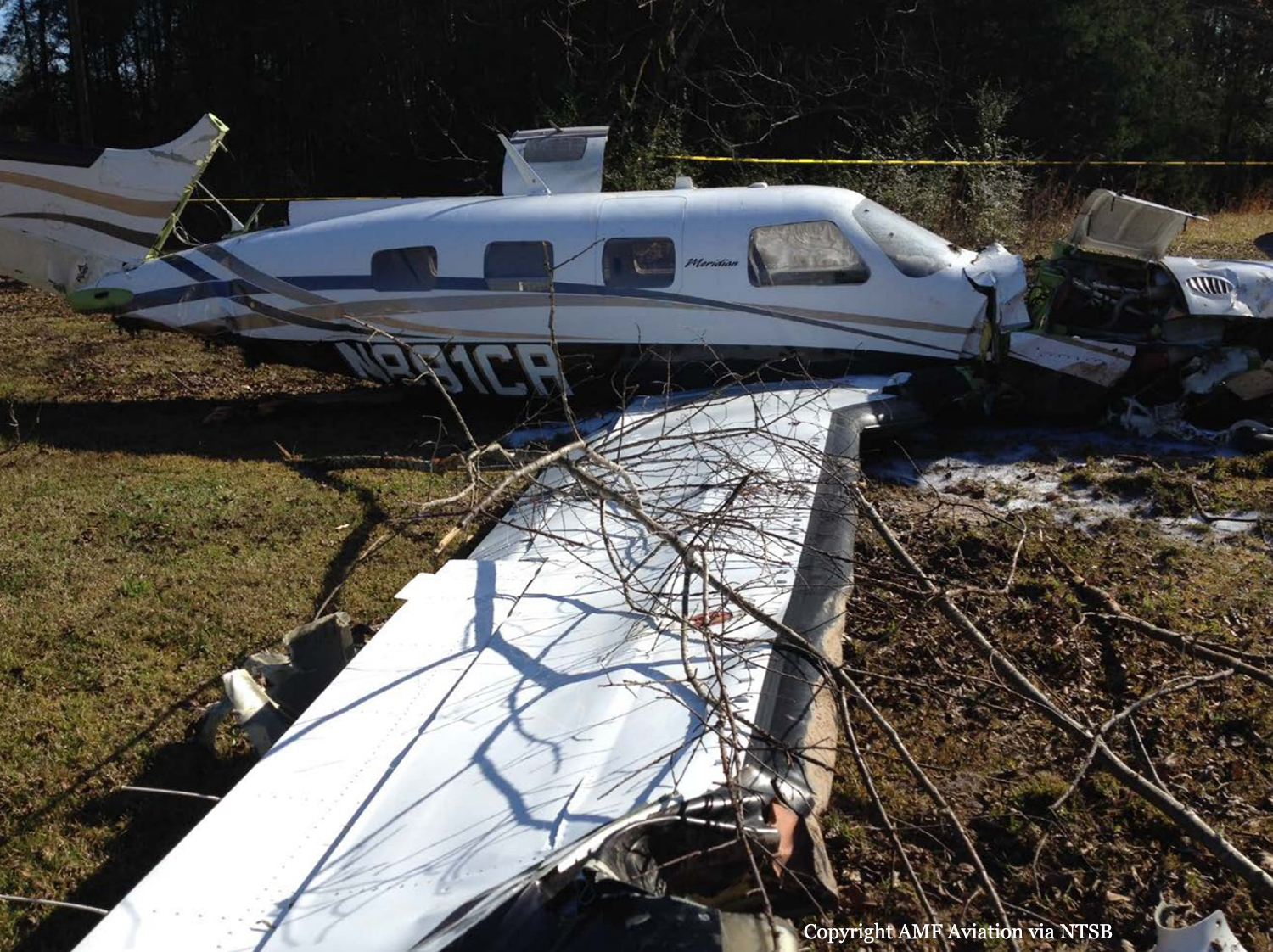Country
Crash of a Piper PA-46-310P Malibu in Harrisburg: 4 killed
Date & Time:
Apr 7, 2017 at 1048 LT
Registration:
N123SB
Survivors:
No
Schedule:
Van Nuys – Eugene
MSN:
46-8508023
YOM:
1985
Crew on board:
1
Crew fatalities:
Pax on board:
3
Pax fatalities:
Other fatalities:
Total fatalities:
4
Captain / Total hours on type:
163.00
Aircraft flight hours:
3681
Circumstances:
The commercial pilot and three passengers departed on an instrument flight rules crosscountry flight. While on approach to the destination airport, the pilot indicated to the air traffic controller that the airplane was passing through areas of moderate-to-extreme precipitation. After clearing the airplane for the approach, the controller noted that the airplane descended below its assigned altitude; the controller issued a low altitude alert, but no response was received from the pilot. The airplane subsequently impacted terrain in a level attitude about 12 miles from the airport. Examination of the airframe, engine, and system components revealed no evidence of preimpact mechanical malfunction that would have precluded normal operation. An area of disturbed, flattened, tall grass was located about 450 ft southwest of the accident site. Based on the images of the grass, the National Weather Service estimated that it would take greater than 35 knots of wind to lay over tall grass as the images indicated, and that a downburst/microburst event could not be ruled out. A downburst is an intense downdraft that creates strong, often damaging winds. About 6 hours before the flight, the pilot obtained weather information through a mobile application. Review of weather data indicated the presence of strong winds, heavy precipitation, turbulence, and low-level wind shear (LLWS) in the area at the time of arrival, which was reflected in the information the pilot received. Given the weather conditions, it is likely that the airplane encountered an intense downdraft, or downburst, which would have resulted in a sudden, major change in wind velocity. The airplane was on approach for landing at the time and was particularly susceptible to this hazardous condition given its lower altitude and slower airspeed. The downburst likely exceeded the climb performance capabilities of the airplane and resulted in a subsequent descent into terrain. It is unknown if the accident pilot checked or received additional weather information before or during the accident flight. While the flight was en route, several PIREPs were issued for the area of the accident site, which also indicated the potential of LLWS near the destination airport; however, the controller did not provide this information to the pilot, nor did he solicit PIREP information from the pilot. Based on published Federal Aviation Administration guidance for controllers and the widespread adverse weather conditions in the vicinity of the accident site, the controller should have both solicited PIREP information from the pilot and disseminated information from previous PIREPs to him; this would have provided the pilot with more complete information about the conditions to expect during the approach and landing at the destination.
Probable cause:
An encounter with a downburst during an instrument approach, which resulted in a loss of control at low altitude. Contributing to the accident was the air traffic controller's failure to
solicit and disseminate pilot reports from arriving and departing aircraft in order to provide pilots with current and useful weather information near the airport.
solicit and disseminate pilot reports from arriving and departing aircraft in order to provide pilots with current and useful weather information near the airport.
Final Report:

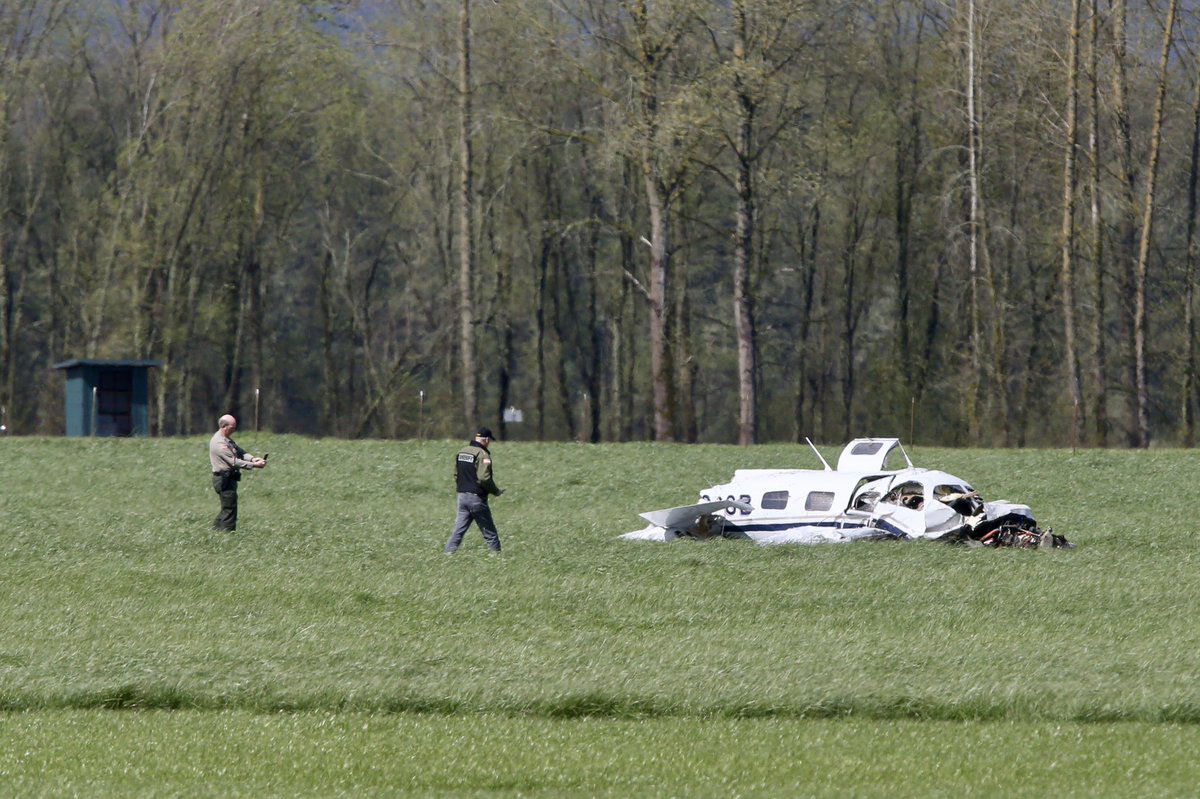

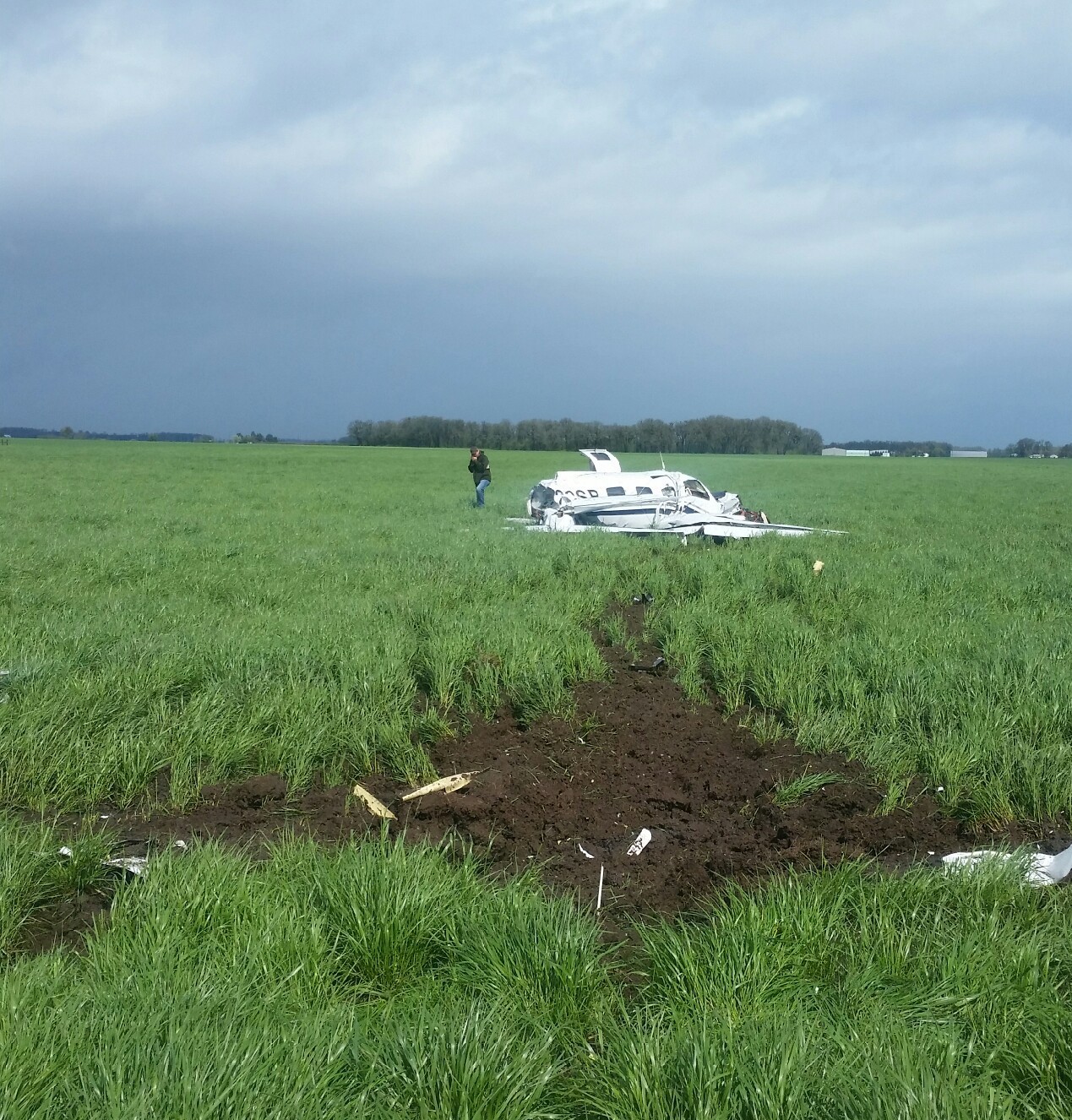
Crash of a Piper PA-46-310P Malibu in Chichén Itzá
Date & Time:
Feb 15, 2017 at 2000 LT
Registration:
N116TH
Survivors:
Yes
Schedule:
Monterrey – Cancún
MSN:
46-8608005
YOM:
1986
Crew on board:
1
Crew fatalities:
Pax on board:
4
Pax fatalities:
Other fatalities:
Total fatalities:
0
Circumstances:
While overflying the Yucatán Province, en route from Monterrey to Cancún, the pilot informed ATC that he was low of fuel and requested the permission to divert to Chichén Itzá Airport for an emergency landing. While approaching the airfield by night, the single engine aircraft descended into trees and crashed few km from the airport. The airplane was destroyed and there was no fire. All five occupants were injured.
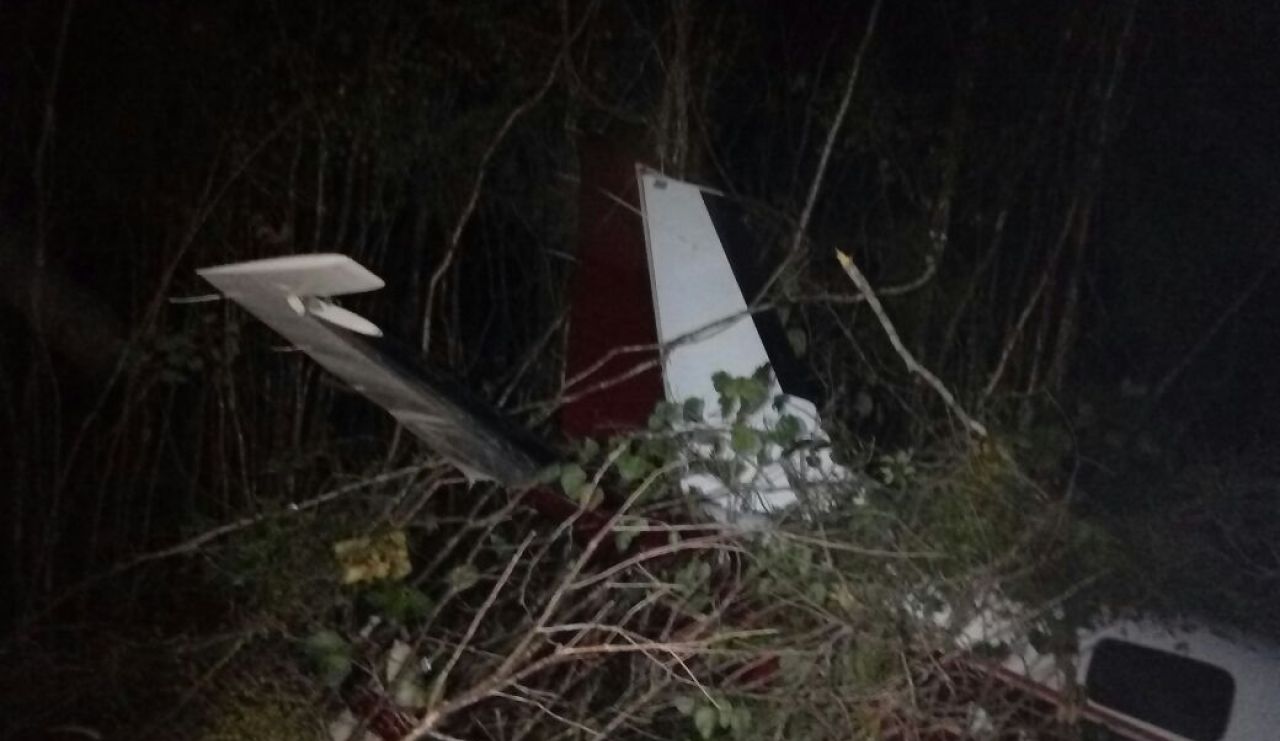

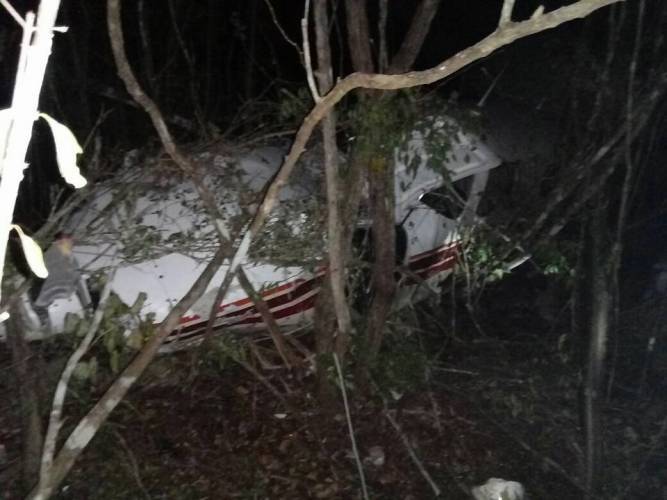
Crash of a Piper PA-46-350P Malibu Mirage in Nashville
Date & Time:
Dec 29, 2016 at 1345 LT
Registration:
N301BK
Survivors:
Yes
Schedule:
Memphis – Nashville
MSN:
46-36407
YOM:
2007
Crew on board:
1
Crew fatalities:
Pax on board:
2
Pax fatalities:
Other fatalities:
Total fatalities:
0
Captain / Total hours on type:
1092.00
Aircraft flight hours:
1332
Circumstances:
According to the pilot, during the landing roll, the airplane "began to drift sharply to the left." The pilot reported that, although there were no wind gusts reported, he felt as though a wind gust was pushing the airplane to the left. He attempted to maintain directional control with rudder pedal application, and he applied full right aileron. The airplane continued to drift to the left, and the pilot attempted to abort the landing by applying full throttle and 25° of flaps. He reported that the airplane continued to drift to the left and that he was not able to achieve sufficient airspeed to rotate. The airplane exited the runway, the pilot pulled the throttle to idle, and he applied the brakes to avoid obstacles. However, the airplane impacted the runway and taxiway signage and came to rest in a drainage culvert. The airplane sustained substantial damage to both wings. The published METAR for the accident airport reported that the wind was from 290° at 15 knots, and wind gusts exceeded 22 knots 1 hour before and 1 hour after the accident. The pilot landed the airplane on runway 20. The maximum demonstrated crosswind component for the airplane was 17 knots. The pilot reported that there were no preaccident mechanical malfunctions or failures with the airplane that would have precluded normal operation.
Probable cause:
The pilot's loss of directional control during the aborted landing in gusting crosswind conditions, which resulted in a runway excursion.
Final Report:
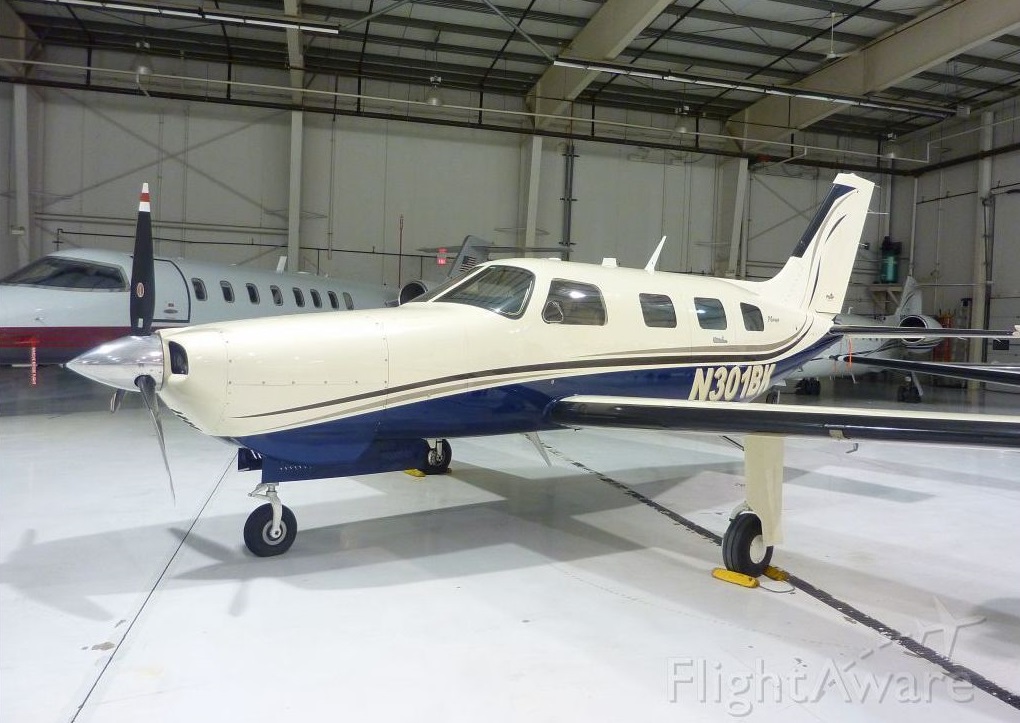

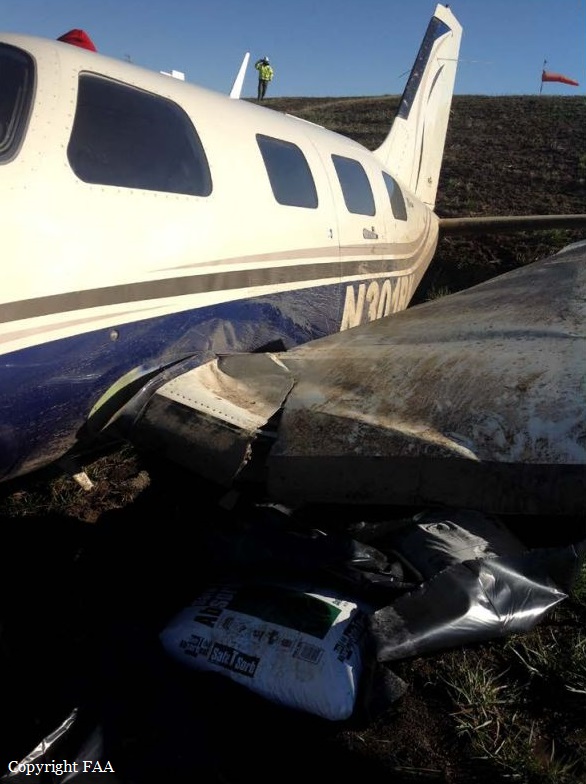

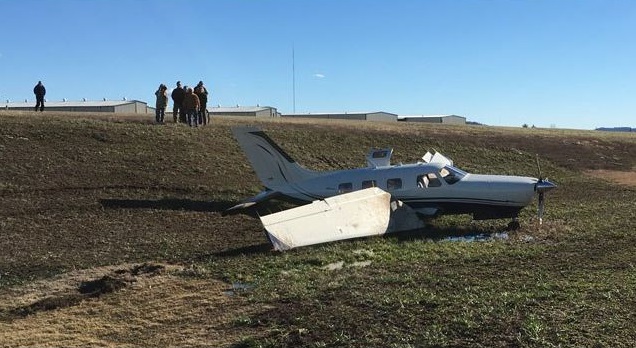
Crash of a Piper PA-46-310P Malibu in Chariton: 1 killed
Date & Time:
Sep 7, 2016 at 1219 LT
Registration:
N465JM
Survivors:
No
Schedule:
Olathe - Ankeny
MSN:
46-8408042
YOM:
1984
Crew on board:
1
Crew fatalities:
Pax on board:
0
Pax fatalities:
Other fatalities:
Total fatalities:
1
Captain / Total hours on type:
118.00
Circumstances:
The noninstrument-rated private pilot was conducting a visual flight rules (VFR) cross-country flight while receiving VFR flight following services from air traffic control. Radar data and voice
communication information indicated that the airplane was in cruise flight as the pilot deviated around convective weather near his destination. The controller issued a weather advisory to the pilot concerning areas of moderate to extreme precipitation along his route; the pilot responded that he saw the weather on the airplane's NEXRAD weather display system and planned to deviate around it before resuming course. About 3 minutes later, the pilot stated that he was around the weather and requested to start his descent direct toward his destination. The controller advised the pilot to descend at his discretion. Radar showed the airplane in a descending right turn before radar contact was lost at 2,900 ft mean sea level. There were no eyewitnesses, and search personnel reported rain and thunderstorms in the area about the time of the accident. The distribution of the wreckage was consistent with an in-flight breakup. Examination of the airframe revealed overload failures of the empennage and wings. No pre-impact airframe structural anomalies were found, and the propeller showed evidence of rotation at the time of impact. Further, there was no evidence of pilot impairment or incapacitation. Review of weather information indicated that the pilot most likely encountered instrument meteorological conditions as the airplane descended during the last several minutes of flight. During this time, it is likely that the pilot became disoriented while attempting to maneuver in convective, restricted visibility conditions, and lost control of the airplane. The transition from visual to instrument flight conditions would have been conducive to the development of spatial disorientation; the turning descent before the loss of radar contact and the in-flight breakup are also consistent with a loss of control due to spatial disorientation.
communication information indicated that the airplane was in cruise flight as the pilot deviated around convective weather near his destination. The controller issued a weather advisory to the pilot concerning areas of moderate to extreme precipitation along his route; the pilot responded that he saw the weather on the airplane's NEXRAD weather display system and planned to deviate around it before resuming course. About 3 minutes later, the pilot stated that he was around the weather and requested to start his descent direct toward his destination. The controller advised the pilot to descend at his discretion. Radar showed the airplane in a descending right turn before radar contact was lost at 2,900 ft mean sea level. There were no eyewitnesses, and search personnel reported rain and thunderstorms in the area about the time of the accident. The distribution of the wreckage was consistent with an in-flight breakup. Examination of the airframe revealed overload failures of the empennage and wings. No pre-impact airframe structural anomalies were found, and the propeller showed evidence of rotation at the time of impact. Further, there was no evidence of pilot impairment or incapacitation. Review of weather information indicated that the pilot most likely encountered instrument meteorological conditions as the airplane descended during the last several minutes of flight. During this time, it is likely that the pilot became disoriented while attempting to maneuver in convective, restricted visibility conditions, and lost control of the airplane. The transition from visual to instrument flight conditions would have been conducive to the development of spatial disorientation; the turning descent before the loss of radar contact and the in-flight breakup are also consistent with a loss of control due to spatial disorientation.
Probable cause:
The non-instrument-rated pilot's loss of control due to spatial disorientation in instrument meteorological conditions, which resulted in an exceedance of the airplane's design stress limitations and a subsequent in-flight breakup. Contributing to the accident was the pilot's decision to continue visual flight into convective instrument meteorological conditions.
Final Report:
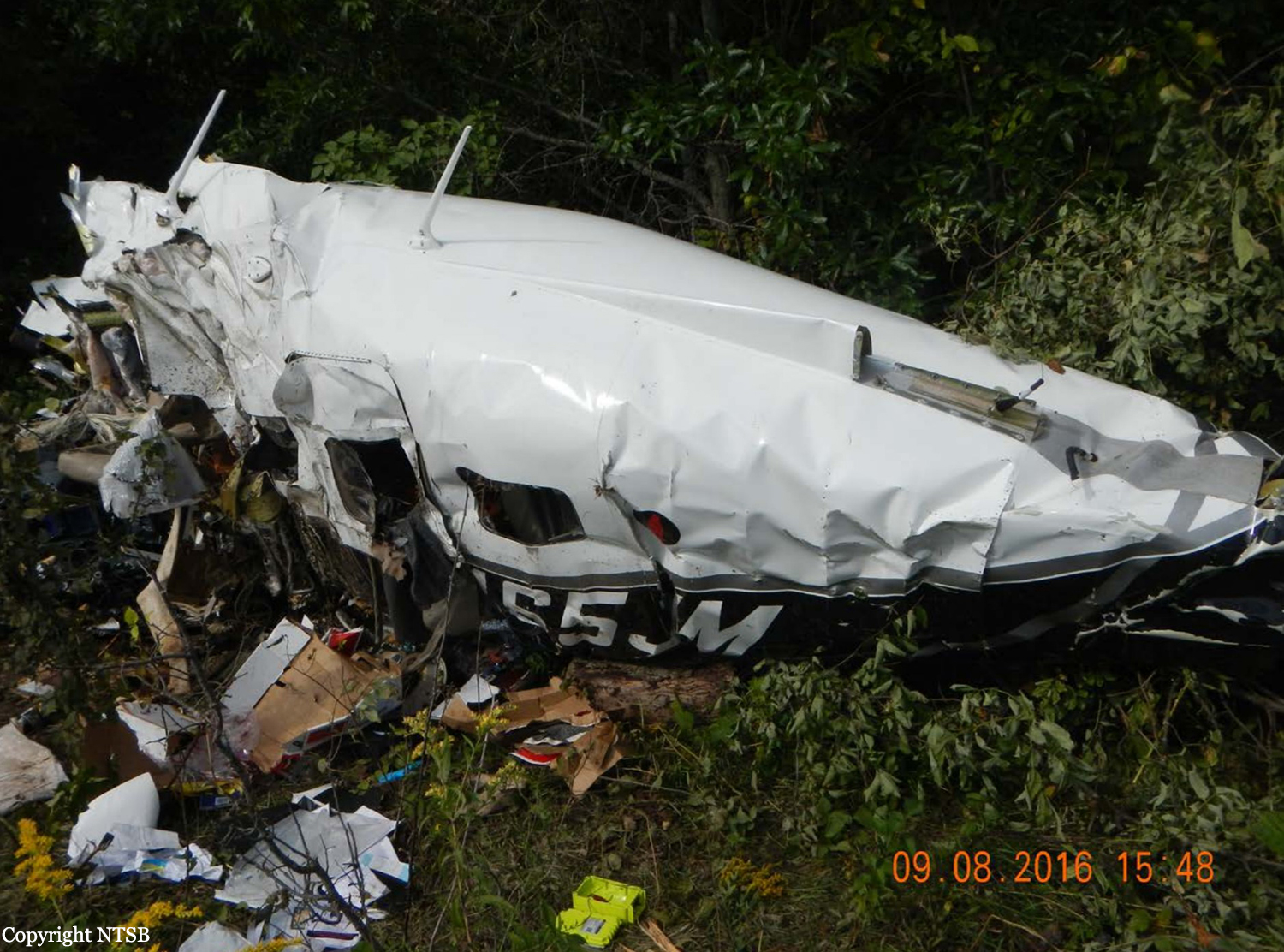

Crash of a Piper PA-46-350P Malibu Mirage in Ottawa
Date & Time:
Jan 19, 2016 at 1250 LT
Registration:
N113WB
Survivors:
Yes
Schedule:
Olathe - Olathe
MSN:
46-22193
YOM:
1995
Crew on board:
2
Crew fatalities:
Pax on board:
0
Pax fatalities:
Other fatalities:
Total fatalities:
0
Captain / Total hours on type:
290.00
Copilot / Total hours on type:
800
Aircraft flight hours:
3100
Circumstances:
According to the flight instructor, he and the pilot rated student receiving instruction were operating under instrument flight rules in instrument meteorological conditions. He reported that throughout the flight the airplane accumulated light rime ice. He recalled that after holding at a Very High Frequency Omni-Directional Range (VOR), they completed a VOR approach, executed the missed approach procedure, set the power to climb at the airspeed of 130 knots indicated airspeed and began to climb to 5000 feet. He reported that as they climbed they encountered freezing rain, the airspeed began to deteriorate and the degree of ice accumulation increased from light to moderate. He reported that all of the airplane's de-ice systems were functioning yet he was not able to maintain altitude. He determined that landing at the destination airport was not an option and executed a forced landing in an open field. He affirmed that during the landing the airplane bounced several times before coming to a stop. The airplane sustained substantial damage to the firewall, forward pressure bulkhead and puncture holes in the airplane skin. The pilot reported that there were no mechanical failures or anomalies prior to or during the flight that would have prevented normal flight operation.
Probable cause:
The flight crews encounter with un-forecasted freezing rain resulting in an uncontrolled descent, forced landing, and substantial damage to the airplane's firewall, and forward pressure bulkhead.
Final Report:
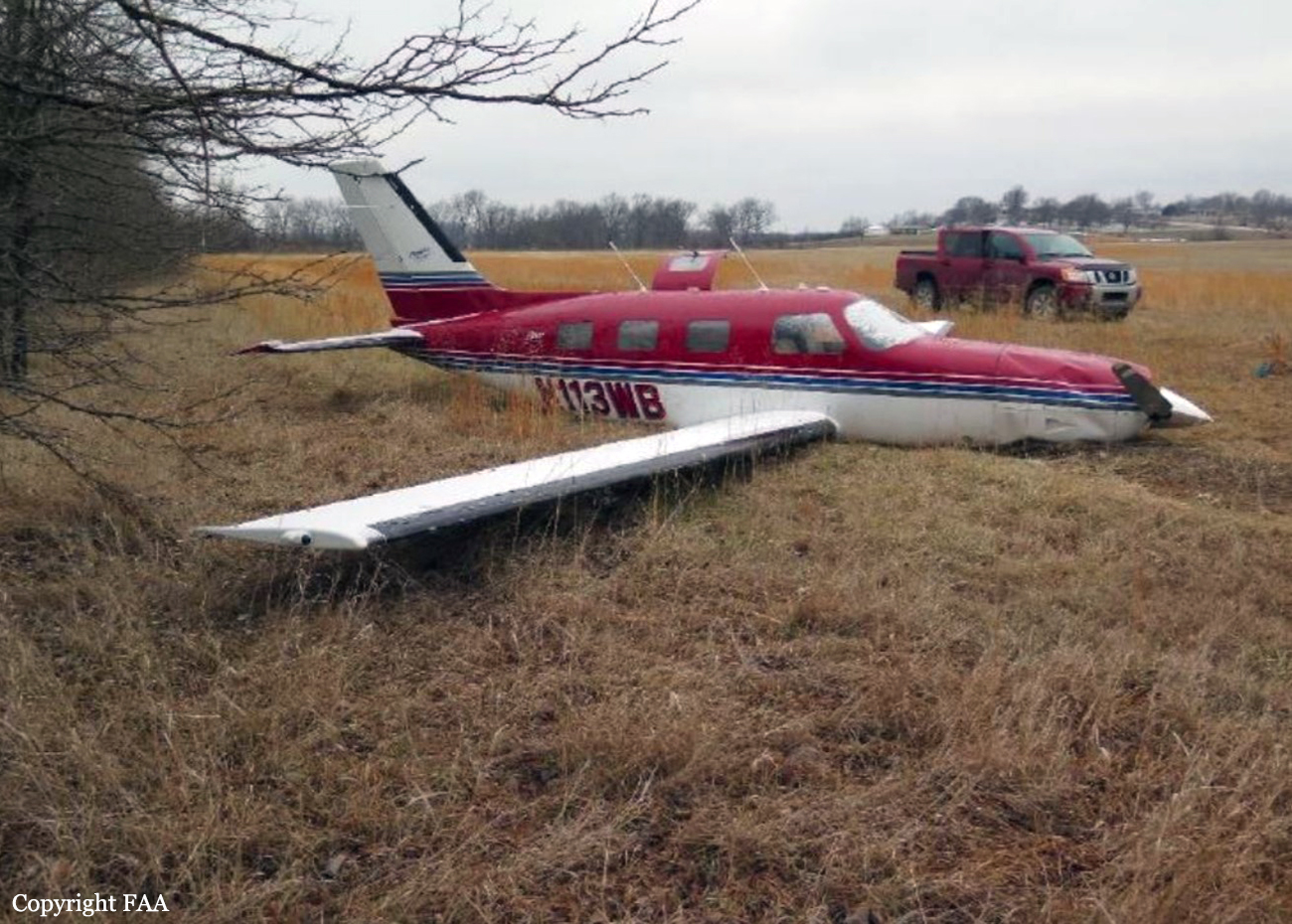
Crash of a Piper PA-46-500TP Malibu Meridian in Corinth
Date & Time:
Dec 24, 2015 at 0840 LT
Registration:
N891CR
Survivors:
Yes
Schedule:
Corinth - Key Largo
MSN:
46-97321
YOM:
2007
Crew on board:
1
Crew fatalities:
Pax on board:
3
Pax fatalities:
Other fatalities:
Total fatalities:
0
Captain / Total hours on type:
427.00
Aircraft flight hours:
1407
Circumstances:
On the day of the accident, a line service technician had disconnected the airplane from a battery charger. After disconnecting the battery, he left the right access door open which provided access to the fuel control unit, fuses, fuel line, oil line, and battery charging port as he always did. He then towed the airplane from the hangar it was stored in, and parked it in front of the airport's terminal building. The three passengers arrived first, and then about 30 minutes later the pilot arrived. He uploaded his navigational charts and did a preflight check "which was normal." The engine start, taxi, and engine run up, were also normal. The wing flaps were set to 10°. After liftoff he "retracted the landing gear" and continued to climb. Shortly thereafter the right cowl door opened partially, and started "flopping" up and down 3 to 4 inches in each direction. He reduced the torque to try to prevent the right cowl door from coming completely open. However, when he turned on the left crosswind leg to return to the runway, the right cowl door opened completely, and the airplane would not maintain altitude even with full power, so he "put the nose back down." The airplane struck trees, and then pancaked, and slid sideways and came to rest, in the front yard of an abandoned house. The private pilot and one passenger received minor injuries. Two passengers received serious injuries, one of whom was found out of her seat, unconscious, on the floor of the airplane shortly after the accident, and died about 227 days later. During the investigation, it could not be determined, if she had properly used the restraint system, as it was found unlatched with the seatbelt portion of the assembly extended. Examination of the wreckage revealed no evidence of any preimpact failures or malfunctions of the airplane or engine that would have precluded normal operation. It was discovered though, that the right access door had not been closed and latched by the pilot before takeoff, as examination of the right access door latches and clevis keepers found them to be functional, with no indication of overstress or deformation which would have been present if the access door had been forced open due to air loads in-flight, or during the impact sequence. Further examination also revealed that the battery charging port cover which was inside the compartment that the right access door allowed access to, had not been placed and secured over the battery charging port, indicating that the preflight inspection had not been properly completed. A checklist that was provided by a simulator training provider was found by the pilot's seat station. Examination of the checklist revealed that under the section titled: "EXTERIOR PREFLIGHT" only one item was listed which stated, "EXTERIOR PREFLIGHT…COMPLETE." It also stated on both sides of the checklist: "FOR SIMULATOR TRAINING PURPOSES ONLY." A copy of the airplane manufacturer's published pilot's operating handbook (POH) was found in a cabinet behind the pilot's seat where it was not accessible from the pilot's station. Review of the POH revealed that it contained detailed guidance regarding the preflight check of the airplane. Additionally, it was discovered that the landing gear was in the down and locked position which would have degraded the airplane's ability to accelerate and climb by producing excess drag, and indicated that the pilot had not retracted the landing gear as he thought he did, as the landing gear handle was still in the down position. Review of recorded data from the airplanes avionics system also indicated that the airplane had roughly followed the runway heading while climbing until it reached the end of the runway. The pilot had then entered a left turn and allowed the bank angle to increase to about 45°, and angle of attack to increase to about 8°, which caused the airspeed to decrease below the stalling speed (which would have been about 20% higher than normal due to the increased load factor from the steep turn) until the airplane entered an aerodynamic stall, indicating that the pilot allowed himself to become distracted by the open door, rather than maintaining control of the airplane. One of the seriously injured passenger passed away 227 days after the accident.
Probable cause:
The pilot's inadequate preflight inspection and his subsequent failure to maintain airplane control, which resulted in an access door opening after takeoff, and the airplane exceeding its critical angle of attack and experiencing an aerodynamic stall.
Final Report:
